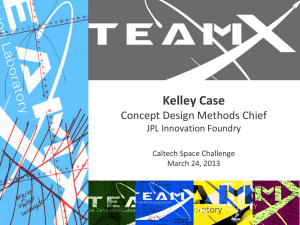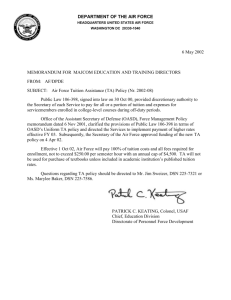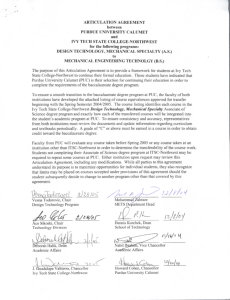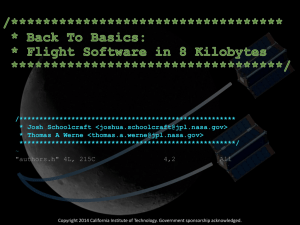03-Naudet-VLBI_transients_final_1
advertisement
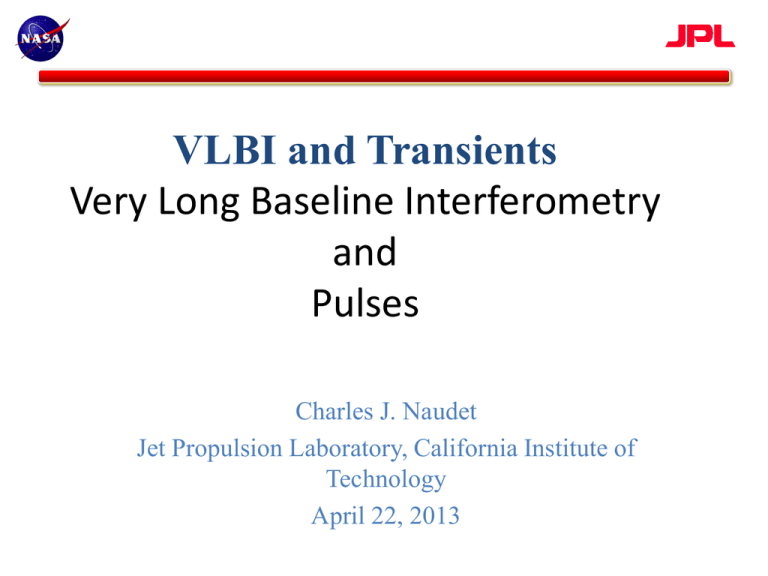
VLBI and Transients Very Long Baseline Interferometry and Pulses Charles J. Naudet Jet Propulsion Laboratory, California Institute of Technology April 22, 2013 Outline • Overview of the Deep Space Network (DSN) • JPL’s Use of VLBI – Mission Tracking Support – Radio Reference Frame – Earth Orientation Parameter Estimation • Transients in General • Recent DSN Transient Studies – GLUE – Crab Giant Pulses – VLBI transients JPL’s Interest in VLBI? • Why does JPL have a 30+ VLBI program? – JPL is responsible for operation of NASA’s Deep Space Network (DSN) – Support for Deep Space Missions • Positions and velocities: – Need accurate tracking and reference frames – Must tie reference frames together » Planetary and Celestial frames • Time: Need accurate clocks and earth rotation data NASA’s DSN • The Deep Space Network, or DSN, is a global network of large antennas and communication facilities that supports interplanetary spacecraft and selected Earth-orbiting missions. In addition it performs radio and radar astronomy observations for the exploration of the solar system and the universe. DSN is part of the NASA Jet Propulsion Laboratory (JPL) The DSN • • • • • • • • • • DSN Capabilities Acquires telemetry data from spacecraft. Transmits commands to spacecraft. Uploads software modifications to spacecraft. Tracks spacecraft position and velocity. Performs Very Long Baseline Interferometry observations. Measures variations in radio waves for radio science. Gathers science data. Monitors and controls the performance of the network. Three tracking and communication sites • ~120 degrees apart Each Site: • 70m antenna, (L,S,X,K-bands) • 34m HEF, several 34-BWG (S,X,Ka) http://dsnra.jpl.nasa.gov/RA_Capabilities.html DSN Spacecraft Tracking The DSN uses range, Doppler and D-VLBI to support Spacecraft tracking The D-VLBI team at JPL (Team Lead: James Border) first pioneered the technique using Voyager and has been operationally supporting missions since 2001 Mars Odyssey. D-VLBI is a Spacecraft-Quasar differential angular technique Radiometric Tracking Techniques for Deep-Space Navigation, C. L. Thornton and J.S. Border ISBN-0-471-44534-7 3-sigma error < 1 Km with MSL at low Dec (~ -25 degrees) • Measures geometric delay by cross-correlating signal from two (2) stations NASA Navigation System Accuracy The high angular angular accuracy of D-VLBI techniques are due to: • The common mode error cancellation: • Clocks • Propagation media • Station platform errors • Improved Quasar reference frames • More quasars sources • Higher astrometric accuracy • Improved Earth Orientation parameter estimation • Improved Frame Ties: • Quasar & Planetary The DSN’s Radio Reference Frame ICRF-2 S/X 3.6cm: 3414 sources 40 µas floor. ~1200 obj. well observed, ~2000 survey session only Credit: Ma et al, eds. Fey, Gordon, Jacobs, IERS Tech. Note 35, Germany, 2009 DSN CAT M&E programs to improve the Radio Reference Frame (CAT M&E team: C. Jacobs, D. Bagri, C. King, A. Romero-Wolf, O. Sovers) • 24 hours VLBI • S-band ( ~ 100 MHz) & X-band (~ 400 MHz) • Go-Ro and Go-Ti baselines one month. • Each exp: 400 sources at 2.5 minutes ~1200 for ~ 30 s • Improvements over time (# bits, PCGs) • Mark6 recorders, JPL’s DVP limit will soon be front-end bandpaths • -> X/Ka Credit: C. King The DSN’s VLBI TEMPO Accurate interplanetary navigation requires accurate knowledge of Earth’s orientation • Error in UT1 of 0.1 ms (4.6 cm) -> a position error at Mars of 1.6 km • Earth’s orientation in space given by 5 parameters: • 2 precession-nutation parameters (Dy, De) •Specifies location of spin axis in celestial reference frame • 2 polar motion parameters (PMX, PMY) •Specifies location of spin axis in terrestrial reference frame • 1 spin parameter (UT1) •Specifies angle through which Earth has rotated about spin axis • Earth’s orientation varies rapidly and unpredictably • • Precession-nutation is particularly easy to predict • Caused by gravitational effect of Sun, Moon, and planets on Earth • Can be modeled and predicted to within 3 cm up to a year in advance UT1 variations are particularly difficult to predict • Rapid UT1 variations caused mainly by changes in angular momentum of winds • Predicting UT1 is as challenging as predicting the weather Measurements of UT1 and polar motion must be taken frequently and processed rapidly to maintain a real-time knowledge of the Earth’s orientation • Credit:Richard Gross JPL Talk, 5/7/2005 THE DSN’s TEMPO To meet Tracking and Navigation Service Requirements (ut1 30 cm (1 sigma) in real time) JPL’s TEMPO (Time and Earth Motion Precision Observations) conducts one six hour VLBI experiment on the Goldstone-Madrid baseline every two weeks. Currently over 150 quasar source over the full sky are examined and the global solution is optimized for Earth orientation parameter extraction. TEMPO Team: D. Bagri, A. Steppe, C. Jacobs A typical TEMPO type solution for the precession and nutation angles for the Global data set . Fast Radio Transients • Strong Impulsive events ranging from nanoseconds to seconds • Known – Giant Pulses from Pulsars – Only ~ 10 known GP emitters --> – • • • RRATS (Rotating Radio Transients) • (McLaughlin et, al, Nature, 439,817,2006) • Repeating Radio sources, 11 found • Detectable via its single pulses, • Like slow erratic pulsars Possible – Lorimer burst, (Science, 318,777, 2007) PSR B0531+21 PSR B1937+21 PSR B1821-24 PSR B1112+50 PSR B0540-69 PSR B0031-07 PSR J0218+42 PSR B1957+20 PSR J1823-3021 PSR J1752+2359 Exotics ? – Magnetars (J1810-197 pulse of 10 Jy and .15 sec widths, – Compact Objects Mergers (Hanson & Lyutikov 2001) – GRB Prompt Emission (Paesold & Benz) – Cosmic Strings (Vachaspati 2008) – Primordial black holes (Rees 1977) Staelin, Refenstein (1968) Crab pulsar Wolszcan, Cordes & Stinebring (1984) Romani & Johnston (2001) Ershov & Kuzmin (2003) Johnston & Romani (2003) Kuzmin, Ershov & Losovsky (2004) Joshi, Kramer, Lyne et al. (2004) Joshi , Kramer, Lyne et al. (2004) Knight, Bailes, Manchester et al (2005) Ershov & Kuzmin (2005) Camilo Nature, 442, 892, 2006) Good Summaries – CRAFT: The Commensal Real-time ASKAP Fast Transients Survey, http://arxiv.org/abs/1001.2958 – The Transient Sky, E. Keane ISBN 978-3-642-19626-19627-0 – Detection of Fast Radio Transients with Multipole Stations, arXiv:1104.4900v1 DSN Transient History • • • • • • • • GLUE: Goldstone Lunar Ultra-High Energy neutrino experiment P. W. Gorham, C. L. Hebert, K. M. Liewer, C. J. Naudet, D. Saltzberg, and D. Williams From 1999-2003 a series of experiments were conducted Coincidence experiment of two antennas (DSS14 and DSS13) 22 km apart at Goldstone Dual S-band with L-band off-axis veto capability with ~ 120 hrs observation time 50ns local gate and 150 msec dual antenna gate (set by years range of moon’s geom-delay), 250 msec data record at 1 Gsam/sec Synthesized IF pulse signal calibration, back-end timing ~ 1ns; pulse transmitter and Limb of the moon for total cross-polarization timing ~ 1 ns. 3c273 for dual antenna timing (~10ns) > 95% livetime, .003 Hz trigger rate GLUE • • • • • • RFI Noise is critical issue, 70m very sensitive – local trigger is easy with a BIC lighter – 60 dBi!, unshielded electrical eq. car motors – Fluorescent lights, cell phones, TVs, radar, lighting, satelites Lessons learned: – Requires multi-antennas, veto – multi-bands, – dual polarization Goldstone is a on a military base and the impulsive noise can be overwhelming. Even with 22 km separation several days the entire experiment was loss, – ~ 100 deadtimes due to RFI Big gates allowed for offline analysis of in and out of time events ( study background) No events above background P. Gorham, K. Liewer, C. Naudet, D. Saltzberg, and D. Williams, (GLUE Collaboration) "Experimental Limit on the Cosmic Diffuse Ultra-High Energy Neutrino Flux", Phys. Rev. Lett., 93, 041101 (2004). DSN Giant Pulse Search • 2008 A small JPL team was formed to search for CGPs – (W. Majid, T. Kuiper, S. Lowe, C. Naudet) • Why GPs ? – Only way to detect extragalactic pulsars – Important for understanding the magnetospheres of Pulsars – Emission mechanism is not well understood – How high energy emission might be linked with radio Emission – Conflicting claims on few detections – Are GPs restricted to small group of pulsars or many waiting to be discovered – Galactic pulsar population may be larger than we thought – Wide range of single pulse properties apparent – Algorithms relevant to transient detection phenomenon • Current study to look for GP Correlation with high energy emission. One way to pinpoint the origin of GP emission. DSN Giant Pulsar Search 70m at DSS14 / DSS63 L-band : 90 MHz of bandwidth, single pol, Tsys ~30K S-band: 100 MHz, dual pol, Tsys ~35K X-band: 400 MHz, dual pol, Tsys ~35K 12 IF channels, 8 MHz wide Baseband I and Q data recorded on VLBI recorders Automated analysis pipeline: • coherent dedispersion (straight-up then sum) • matched filter algorithm Widths *= 1,2,4…2048 High time resolution reaching ~100 ns Frequency-Time Plot Noise Statistics • Model noise as Chi-squared distribution with proper ndf • Automated accounting of ndf with varying sub-bands and time resolutions • Excellent agreement over 8 orders of Magnitude. Nice white noise! • Define R to be false alarm rate to pass threshold cut equivalent to choosing a constant event confidence level independent of pulse width Crab Phase-Time Plots Loose Cuts The false alarm noise level (R) Strongly impacts the number of GPs and GP SNR. Tight cuts (R=.0006 Hz): SNR= ~38 Loose cuts (R=.6 Hz): SNR= ~25 In/out phase Pulsar GPs essential tool For transients studies Tight Cuts Pulse Morphology Wide variety of pulse shapes and sub-structure. Examination of in-phase to out-phase • White noise pulses and GPs almost indistinquishable • Small Kurtosis differences seen Crab GP Energy Isotherms Crab GP cover 3 orders in Pulse width and Flux Density Crab GPs • • • • To date L-band: S-band: X-band: 15 exp: 42 hours, 1 exp: 3.75 hours, 4 exp: 16 hours, ~ 45K GPs, ~ 1800 GPs, ~ 383 GPs, ~.29 per sec ~.13 per sec ~.006 per sec • Majid,Naudet,Lowe,Kuiper, APJ, 741, 2011, • ~60 hours of data ~ 50 Tbytes of disk space • Total reprocessing time on current machine ( 16 threads) ~ 2 week • Current Rule of Thumb: 1 hr of data needs 1 TB and 6 hrs of cpu for 1 DM • RFI : Only a handful of seconds per experiment need to be removed – Ave and rms power calculated every sec for data assessment – Near antenna on / off source. – DM of 56 pc/cm3 solves most of RFI problems – Caution in calibration: modulated diodes, Phase Calibration Tones Noise Calibration Issues: • Phase calibration tones yield nice pulses in time domain but are problematic Crab Pulse Phase At L-band a 550 sec period RFI Noise was seen. • Easily removed by dropping a 4 MHz Channel • All seen at DM=0 • DM smeared out • All pulses very wide (> ~.25 msec) • Seen at DSS14 and DSS63 • Source unknown (Satellite or common equip?) • Easily detected by monitoring ave (ndf) L-band FERMI GP Off point On point • Modulated Noise diodes similar • Both can be filtered, currently work in progress. • Calibration during precal is ideal Time (seconds) Surveys Due to small amount of fast transients a diversity of search parameters is very important Transients programs growing leaps and bounds • Past Surveys (see details in VLBA paper arXiv:1104.4900v1) – ATA Fly’s Eye (von Korff et al. 2009) – LWA transients study (Taylor et al. 2006), – LOFAR transient campaign (Hessels et al. 2009), New surveys coming on line will set the bounds on rates ! • CRAFT (Johnston et al. 2008), Murchison Widefield Array (MWA) (Lonsdale et al.2009), and MeerKAT (Jonas 2009) • Nice VLBA paper: V-FASTR limits arXiv:1205.5840v1 – 1300 hours from 327 MHz -86 GHz. (112 hours at S-band) – No single-pulse events found • • • • • • Current Efforts: ( via CRAFT paper) – Freq Time Res Parkes 1.4 GHz 64 ms VLBA .6-.9 GHz 2-10 ms GMRT .3-.6 GHz 32 ms LOFAR .12 GHz 50 ms JPL 2.2 & 8.3 GHz .2 -- 35ms Sensitivity (1s) 1.5 mJy 5.6 mJy 22 mJy 40 mJy 18 mJy Baseline NA 200 - 8600 km NA 1000 km 10000 km Starting 9/2009 2/2010 done 2010 2012 Looking for Transients in JPL’s VLBI Data • Use JPL Operational VLBI for Transients searches (no $$$) – – – – – – 34m ant (FWHM=.24 degrees), S/X-band, Over 100-200 hours a year, Multi-year future, long term monitoring Full sky, ~500 sources, repetitive Apply GP matched-filter at both antennas individually. Apply VLBI clock offsets and total geometry delay corrections then coincidence For proven transients full correlation astrometric information • But – Must be NIB (non-interference basis) Must Filter PCGs • Problems – Data logistics – CPU intensive – All transient surveys must show events are not of terrestrial origin and all are very sensitive to impulsive RFI – RFI mitigation is a challenge for all teams. Phase 1: Shake out • • • • • • • CPU and Disk space limitations Incoherent dedispersion ( min pulse width ~.2ms) Limit DM search from 0 to 500 pc/cm3 Set SNR cut high enough to inspect all Candidates manually (~ 1 candidate hit/hr ) Require clean and clear Frequency-Time plots Develop RFI diagnostics plots RFI removal techniques Status Phase 1: Completed ~ 40 hrs of VLBI Full Sky ~ 50 candidates: One 1 pair Dt < 1 sec DSS15 SNR=18 DM= 0.14 DSS65 SNR=12 DM= 2.4 Dt> .3sec & DDM> 2.3 Low DM No VLBI Transient Candidate yet. • Phase 2 (starting now) – Install new CPU with 75 Tbytes disk space – Reduce SNR thresholds in incoherent dedispersion searches – Increase DM search range 0 to 2000 pc/cm3 – Save all dual hit candidates and reproprocess with coherent dedispersion – Use new VLBI DVP recorder ( allow full bandwidth, 100 MHz at S-band) – Negotiate adding in a Giant Pulsar cal source once per track – RFI Mitigation improvements. Algorithms development – Increase search space to msec seconds minutes Related JPL Efforts • Study of Electrical Activity in Martian Dust Storms with the Deep Space Network antennas – Martinez, S.; Kuiper, T. B. H.; Majid, W. A.; Garcia-Miro, C.; Tamppari, L. K.; Renno, N. O.; Ruf, C.; Trinh, J. T. – http://adsabs.harvard.edu/abs/2012espc.conf..937M • Current effort is being made to implement a real time transient detector for all the IFs and antennas in the DSN • The DSN Transient Radio Observatory – Kuiper, T. B.; Lazio, T. J.; Majid, W. A.; Navarro, R.; Teitelbaum, L. P.; Trinh, J. T. – http://adsabs.harvard.edu/abs/2013AAS...22143914K

